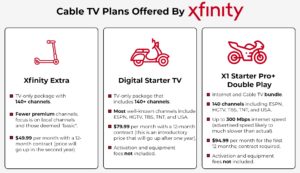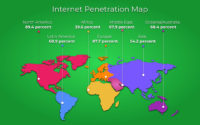Cable TV Costs vs. Streaming Options In 2020
Watching television is a classic American past time. Ever since the 1950s, when the TV started becoming a staple in homes across the country, we have fallen in love with countless characters and shared so many precious moments while gathered around the TV.
However, while those of us living in the modern age watch TV more than any past generation, the way we do it is dramatically different from previous years. First came antennas (the famous rabbit ears), and then cable. Now, we have internet streaming platforms. While no one thought this could happen, these new ways of watching TV are rapidly becoming the norm, with millions of people deciding each year to “cut the cord” and say goodbye to cable forever.
A big reason why so many are doing this is that cable’s price has been steadily increasing over the past few decades to unsustainable levels, often significantly outpacing inflation. Combine this with the fact that all this extra money spent often leads to very little additional value, and it’s easy to see why so many people are changing.
Is Cutting the Cord Really Cheaper?
People have been cutting the cord in droves over the past few years to save money, making it easy to conclude that it’s a cost-saving exercise. But is this truly the case?

We’ve put together this guide to help outline the many different aspects involved in deciding to stick with cable or ditch it and the various costs involved.
Cable TV vs. Streaming at a Glance
For those not interested in all the details, here’s a summary of the information we’ve compiled below:

Advantages and Disadvantages of Cable TV
Before going into the costs of a cable TV subscription, here’s a summary of what makes cable a better option than streaming:
- Put all your TV in one place – When you go with cable, you don’t need to worry about linking up different services. All you need to do is turn your TV on and watch. Most cable plans allow for DVR service, which means you can record and watch your favorite shows whenever you want.
- Access to local channels – Because of licensing agreements, many of the live streaming TV options we’re going to discuss below don’t offer you the same amount of local channels as traditional cable, although this is changing. For those concerned about this, make sure you double-check what’s available to you before making your decision.
- Bundles – Cable companies are also phone and internet companies (usually.) While this is somewhat troublesome from a competition standpoint, it can offer you as the consumer the chance to save by bundling services into one package, which usually gets you a discounted rate on each.
- Cable-specific channels – The channel lineups on streaming platforms are limited (albeit growing.) This means that if you switch off cable, you will have to decide if you can live without the channels only offered through traditional TV packages. For some, this isn’t as big a deal as it is for others, so take a look at what you might be losing if you decide to cut the cord.
On the other side of things, the main drawbacks to cable are:
- Price – As mentioned, the cost of a cable subscription has been going up. While some companies have tried to make plans more competitive to stay relevant, it appears this upward trend will continue.
- Promotional pricing – Unfortunately, it’s tough to ever know for sure how much you’ll be paying for cable. Almost all companies do the same thing: lock you into a year at a promotional price and then raise it after the first year. It’s virtually impossible to get the original rate back. This is always in the fine print, but is a dodgy practice and leads to lots of frustration. Make sure you know what will happen to your rate before you sign up for a new plan.
- Equipment rental – To make your cable work, you need modems, receivers, boxes, and more, all of which the cable companies “rent” to you, which jacks up your monthly bill. If you think you will be with cable for a while, you can buy this gear for yourself and save money, but you’ll be responsible for updating it when it gets old.
- Contracts – Most cable companies require you to sign a one- or two-year service contract that comes with a hefty penalty for early cancellation. It’s also quite common for the price to be higher during the second half of a contract than the first, which can be frustrating while also bringing unwanted surprises to your bills.
- Advertisements – Although you pay for cable, the specific channels still need to earn money to produce their content, which means you will be subjected to advertisements. You will not need to deal with these with most streaming services.
- Fewer choices – There are just one or two choices available for cable TV in most markets, making it hard for consumers to shop around and get the best deal, and is also a big reason why costs have been rising.
As we mentioned, the average cost of a cable TV subscription is around $200, but most people report paying about $100. This difference most likely comes from negotiated and promotional pricing, as well as bundles.
To get a bit more specific, we’ve taken a cross-section of the different cable plans out there to give you an idea of what to expect and how much you will spend, if you decide to go with a cable subscription:
Top Cable TV Providers
Below is a list of the major cable providers as well as their most popular plans. Of course, you need to keep in mind that the actual plans available and their cost will depend on your exact location, but this should give you a snapshot.
Xfinity
One of the nation’s largest cable TV companies, here are Xfinity’s most popular plans:

There are many more plans to choose from, including bundles that give you home phone, TV, and internet, but this should give you an idea of what to expect. Basic plans without internet are pretty affordable, but they aren’t particularly practical since everyone needs internet. Expect to pay somewhere around $100 for a plan with Xfinity.
AT&T
Xfinity’s main competitor, AT&T, is available in cities all around the country. It has its own cable service – U-Verse – and it also owns DirecTV, which could be an option for some.
Here’s a summary of the different plans you can get with AT&T:

Once again, these are just two of the many plans that are currently being offered by AT&T. You can easily get more channels and spend more money, but we feel these represent decent, middle-of-the-road packages that will please most people. However, as you can see, pinpointing the exact cost of a cable subscription is difficult due to their use of promotional pricing and hidden fees.
Spectrum
Another major player in the cable TV world, Spectrum has some really exciting deals, although it is not as widely available as the other two names on this list. What makes Spectrum a good deal are there bundles. Here’s a sample of a what’s out there to give you an idea:
- Spectrum Double Play Select
- 125+ channels
- Free HD programming
- Internet speeds up to 940 Mbps
- Modem included
- $89.98 per month for 12 months
Spectrum has several upgraded versions of this plan if you want more channels, which will cost you between $25-$35 per month more. It’s worth noting that Spectrum provides several things for free (modem and HD channels), and that internet speeds are advertised to be much higher. Those wishing to stick with cable would do wise to see if Spectrum is available in their area.
Cost of Streaming
Now that you’ve seen what you get for your money when you go with cable, it’s time to look at the different streaming services that are out there so that we can make a full comparison of the costs. But first, here’s a summary of the pros and cons of streaming:
Advantages and Disadvantages of Cable TV
The main benefits of streaming are:
- Watch anywhere you want – Use your computer, phone, or tablet to watch content whenever and wherever you want.
- No contracts – Sign up when you want, and if you’re not happy, or find yourself not watching much, you can cancel and don’t need to worry about paying any early termination fees.
- Share accounts – Most streaming platforms allow you to share your login information with at least two other people, which means you can split the cost of the subscription and save money.
The main disadvantages of streaming are:
- Requires a solid internet connection – For regular streaming, you will likely need a connection of at least 25 Mbps, but 50 Mbps is necessary for streaming in 4K Ultra HD, which is rapidly becoming the norm.
- Need multiple accounts – To get all your content, you’ll need to switch between various apps and platforms. There are tools out there to make this easier, but it can certainly be a pain for those used to the ease of cable.
- Constantly changing services – In the beginning, there was just Netflix and Hulu. Now, there are many more platforms, and keeping up with everything can be confusing, and, if you’re paying for everything yourself, quite expensive.
High-Speed Internet
Clearly, streaming options offer you a much different experience than cable, one that many would consider is more in tune with the modern consumer’s needs. As you will see below, taken on their own, streaming services seem to be much cheaper. However, it’s important to remember that streaming requires a fast internet connection, which is likely to cost you between $50-$70 per month, if not more (it depends on your area).
So, when considering the cost of streaming, it’s essential to keep this in mind. Of course, you need an intent connection no matter how you watch TV – it’s a requirement for modern life – but if you don’t already have this type of connection, then you might need to upgrade, which will eat into the perceived savings of switching to streaming-only services.
Top Streaming Options
To help you figure out the difference in cost between cable and streaming, we’ve provided a brief summary of the primary streaming services out there and a bit about what makes them a good option.
YouTube TV
YouTube TV is a live TV replacement that offers you 50+ channels for $49.99 per month. You can add up to five people to your account and stream simultaneously on three devices (which makes it great for sharing) and also make use of its unlimited cloud DVR.
For those looking for more, there are many add-ons available, such as Starz, HBO, Showtime, Sports, and more. But these will, of course, increase the overall cost of your subscription. Most of these add-ons cost around $10 per month each.
Hulu + Live TV
A very similar service to YouTube, Hulu + Live TV gives you access to Hulu’s massive library of television shows and a channel lineup that is almost identical to that of YouTube TV. It costs $54.99, but considering it includes Hulu; this does make it a slightly better value.
However, Hulu’s DVR is limited to 50 hours, and getting more space comes at a cost.
Just like YouTube TV, there are lots of different add-ons, which range from only $5 to $15 per month.
If unlimited DVR space isn’t a priority, then Hulu + Live TV is excellent value for those looking for a live TV alternative.
Sling TV
Slightly cheaper than its competitors YouTube TV and Hulu, Sling TV boasts it is the most customizable live TV streaming service. Based on your preferences, you will choose either the Blue or Orange package ($30 per month) and then add what you want.
There are many different choices (sports, comedy, news extra, and more), making it easy to feel as though you’re only paying for exactly what you want.
Netflix
Moving away from live TV options and into streaming platforms, Netflix is the name we all know. The most popular plan costs $16 per month. You can spend less, but you won’t be able to stream in 4K Ultra HD.
The big draw to Netflix is its original programming, which has been winning awards nearly every year for the past few years. Films such as Roma (Academy Award winner for Best Picture, 2019) and The Irishman (Nominated for best picture in 2020) are only available on Netflix. This doesn’t include the hundreds of original TV shows.
A subscription to Netflix is a must for those looking for the most unique and most interesting original content out there.
Hulu
Hulu is another big player amongst the streaming platforms, but its focus is a bit different. There is some original programming (The Handmaid’s Tale, for one), but Hulu’s real benefit is that it carries lots of network shows, and new episodes are usually available the next day.
The basic version of Hulu costs just $7 per month but includes ads. If you want the ad-free version, it’s $12 per month. It’s a great option for those who want to keep up on some of the programming available on cable but don’t need to see it live.
Amazon Prime
When you sign up for Amazon Prime, you get access to free two-day shipping, discounts on tons of items, and the ability to watch content on Amazon Prime’s video library. Here you’ll find some quality originals, such as The Marvelous Mrs. Maisel, but you’ll also find lots of other movies and TV shows from other networks.
In truth, the Amazon library isn’t as exciting as those of the other platforms discussed, but if you’ll make use of the benefits of a Prime membership, then it’s a no-brainer to sign up for this service.
Disney+
New in 2019, Disney+ is a streaming platform that includes not only all of Disney’s content but also that of Pixar, Lucas Film (Star Wars), and Marvel. It’s geared towards families and younger audiences, but there is plenty there for everyone, plus some exciting original programming, such as the first-ever live-action Star Wars television show, The Mandalorian.
At the moment, Disney+ is available for just $7 per month, although there is wide speculation that this is an introductory price and that it will go up soon. So, if you’re interested, we recommend acting while the iron is hot!
HBO Max
The longtime standard-setter in the world of original TV, HBO has been working to compete in a changing cable landscape, and their latest attempt to do so has been to launch HBO Max. For 14.99 per month, you can get access to all of HBO’s past and present content (The Sopranos, The Wire, Game of Throne, The Watchmen, etc.) and many other titles from other networks; a feature included to increase the platform’s appeal.
Currently, HBO Max costs $14.99 per month. However, those who already subscribe to HBO via cable or HBO Now (the company’s former streaming service) will automatically have access to this new platform.
Others
These are the major players in the world of streaming, but know that there are countless others, some of which are free. For example, Hoopla and Kanopy offer movies and TV for free through your library account. Crackle TV and Tubi are free versions of Hulu (albeit it with less content), and there are also services out there explicitly tailored to fans of horror (ScreamBox), anime (CrunchyRoll), cartoons (ToonGoggle), and much, much more.
If you have specialized tastes, we recommend looking for a platform that meets your needs. Remember that this is one of the many benefits of streaming: you choose what you want to watch.
Conclusion: Which is Cheaper?
Now that we’ve looked at all the different options and how much they cost, here’s the verdict: streaming is cheaper if you limit yourself to just two streaming services or share their costs with others.
We figured this out by taking the average cost of an internet connection ($50) and adding it to the average cost of two streaming platforms (2 x ≈$15 = $30). Add another streaming platform, and you’re paying roughly the same. Of course, if you decide to go with a live TV replacement such as YouTube TV, you will wind up paying roughly the same ($50 + $50 = $100).
If we exclude the internet cost, then streaming will be cheaper, but we feel this skews the data and makes things appear not quite as they are.
We need to mention one caveat: the cable prices we looked at were promotional prices, meaning they are cheaper than what most people pay.
It’s very likely you’re currently paying upwards of $200 per month on cable because of an old plan, making streaming a great option. Or, if you don’t want to make this switch, this should at least be a sign that it’s time to renegotiate the deal you have with your cable provider.
In conclusion, neither cable nor streaming is necessarily cheaper. However, streaming certainly can be, which means that the main factor in your decision will ultimately be your personal preferences and what you want to get out of your television experience.

